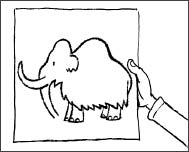The Time Travelers' Handbook (5 page)
Read The Time Travelers' Handbook Online
Authors: Lottie Stride


You have landed on a running track in a huge stadium that is packed with noisy spectators on all sides. It's day one of the Ancient Olympiad, the biggest festival in Ancient Greece, celebrated in honor of Zeus, king of the Greek gods.
Just like the Olympics in modern times, the Olympiad is held every four years, but always here in the city of Olympia. The festival is considered so important that wars between cities are stopped so that the athletes can travel safely to the games.
Fighting Fit
Nervously, you line up with a group of boys who are about your age and size. They're all warming up for a 192-metre (210-yard) sprint from one end of the stadium to the other.
The Ancient Greeks think being fit and healthy is very important. All boys in Ancient Greece do a lot of athletic training, and these are the cream of the crop. They've been training hard for months in a place called the
palaistra
, the wrestling school. They have been eating healthily and working hardâwhich means you're up against some tough competition.
As you are waiting for the starter's orders, follow these top tips:
⢠Try not to let the butterflies in your stomach bother you. They'll go away as soon as you start running. They're caused by your body producing a chemical called adrenaline. This is completely natural and will give you a burst of speed across the stadium.
⢠Don't worry about not having your running shoes with you. Take a look around. No one else is wearing anyâin fact, they aren't wearing anything at all! Ancient Greek men and boys trained and competed completely naked. So strip down and get ready to run.
⢠Try to block out the roaring crowd and go through the race in your head. Imagine yourself being super-speedy and think how good you'll feel when you cross that finish line first.

What Next?
The downside is that if you win, you shouldn't expect a medal. Ancient Greeks didn't do medals. Winners get a crown made out of olive branches.
The good bit is Olympic winners are celebrities and are greeted by cheering crowds when they return home to their towns and cities. In the meantime, while you are in Olympia, you can expect some nice free meals and front row seats at the theater. You may even get a statue built in your honor.
While You Wait
If you win any of the races, you'll have to hang around for your prize, because the Ancient Olympiad goes on for five days and the prizes are all given out at the end.

Here are a few things you can do while you're waiting:
⢠What better way to while away the hours than taking in a chariot race or two? There are two-and four-horse events, as well as a cart and mule race. Chariot races are very exciting with up to 40 chariots jostling for first place during the 12 laps. You might not want to sit in the front row for this one, though. Crashes are common and you don't want to get trampled by a runaway horse.
⢠For a seriously tough sport, why not watch some boxing? The boxers don't wear gloves like modern boxers, they just wrap bits of leather around their hands, leaving their fingers sticking out.
The boxing matches don't have rounds; each fight continues until someone gives up or loses consciousness. Watch out for a man named Theagenes of Thassosâhe is said to be this year's favorite. At the age of nine, he was so strong that he managed to tear a bronze statue of a god off its base and carry it home.
Boys Only
Sorry, girls. The Ancient Olympiad is for boys and men only. Girls aren't even allowed to watch the games, and any girl caught trying to is punished.

Don't worry, a separate festival in honor of Zeus' wife, Hera, is held here in Olympia. It is called the
Heraia
and takes place every four years, too. The
Heraia
is the Ancient Greek girls' chance to show off their running skills. To compete, girls wear tunics cut just above the knee and draped over their left shoulder.

It's pitch-dark. You can't see a thing, and you have no idea where you've landed. Luckily, all TT handsets are equipped with an emergency illuminator switch. You press it, and at once, the room is flooded with light. But it's not a room at all. You are inside an enormous cave, and there's an incredible painting of two huge gray bulls on the wall in front of you.
You walk farther on and see wall after wall covered in paintings of huge animals. Up ahead, you see light glimmering. Follow the light, and you find yourself in another huge cave about 100 feet long. There's someone in here hard at work, sketching the outline of a leaping horse on the cave wall.
You're in the Lascaux Cave, in the Pyrenees Mountains in France. The cave is one of a series of caves and tunnels filled with what will become some of the most famous Stone Age cave paintings in the world. The gallery you're in right now is known as the Painted Gallery, and has walls 11 feet high.
Shedding Some Light
The glimmering is coming from a flat sandstone lamp with a hollowed out dip at one end. The artist has filled this dip with something that is burning brightly enough for you to see what he's doing.
The paintings you have seen are all in browns, blacks, reds, and grays. The artist is using paints made from minerals and natural substances. Some rocks contain a lot of iron oxide; this substance gives a rusty red color. Rocks containing a mineral called manganese oxide give a strong black color. The artist shows you how he grinds rocks down to a powder and mixes the powder with either water or grease to make it easier to apply to the cave walls.

Paint Your Own Cave
The artist hands you his painting implement and now it's your turn to try painting a mammoth.
You will need
:
⢠paper ⢠a pencil ⢠crayons ⢠a cup of cold dark tea ⢠a large paintbrush
First, sketch out your design on paper using a pencil. Don't worry if you aren't a great artist. Cave paintings tend to be very simple. The more simple yours is, the more real it will look. Why not draw a mammoth following these simple steps?

1
. First draw the mammoth's outlineâwith a hump for its head and one for its back (it should look like a fat M shape.)

2
. Add the bottom of the mammoth's trunk and its mouth. Don't forget the shaggy fur.

3
. Next, draw the ears, eye and tusksâ¦

4.
â¦and some legs.

Using a large paintbrush, cover your paper with cold tea to give it that authentic ancient-cave look. You should still be able to see your drawing through the tea. Don't worry if your paper wrinkles.

Now, you're ready to go over your mammoth with crayons. The cave painters didn't have a lot of colors to choose from, so stick to reds, orangey yellows, browns, and blacks for an authentic look.
Top Tip:
Why not think bigger? Get hold of a roll of newsprint paper and create a long row of animals along one wall of your bedroom. Add lots of stick men holding spears. Don't draw right on your walls. You may think it's the best way to relive your cave painting experience, but chances are your mother will get angrier than a mammoth with a spear in its side.
